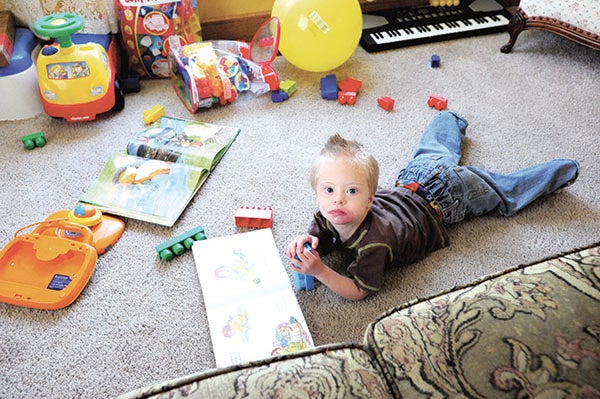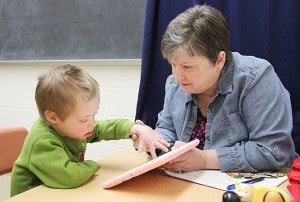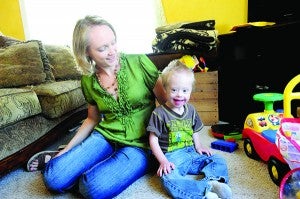Technology aids in teaching disabled boy to learn words
Published 6:00 am Sunday, March 2, 2014

Kaiden Hoelz plays with books and toys on the floor of his home. He has Down syndrome and autism, and a new computer device is helping him learn to communicate. –Brandi Hagen/Albert Lea Tribune
When Albert Lea boy Kaiden Hoelz was 11 months old, he said his first and last word: “Mama.”
At the time, Kaiden, who has Down syndrome, had been suffering from benign myoclonic seizures for about four months. At the worst, he had six clusters of seizures a day with one spasm every 10 to 15 seconds for anywhere from 10 to 45 minutes.
The seizures went on for about five more months until little by little his mother, Anne, determined that by changing his diet, she could eliminate them. She said though the seizures stopped at age 16 months — and Kaiden has since become a more alert and happier child — his verbal communication has not returned.
“It’s just so hard,” she said of her now 5-year-old boy who attends preschool at Brookside Education Center. “He can’t communicate. It’s just all nonverbal.”
Albert Lea Area Schools speech pathologist Viki Segler said Kaiden’s dual diagnosis of Down syndrome and autism, combined with severe speech and motor apraxia, have made his learning to communicate more difficult.

Albert Lea Area Schools speech pathologist Viki Sigler uses an app on an iPad with 5-year-old Kaiden Hoelz this week at Brookside Education Center. Sigler and Hoelz’s family are working to get a device to help Kaiden, who cannot talk, communicate. –Sarah Stultz/Albert Lea Tribune
Anne said having speech and motor apraxia means Kaiden is unable to talk or sign. But, in the past six months to a year, Kaiden has started making more of an effort to show that he wants to communicate, Anne and Sigler said.
A ray of light
In October, Sigler attended training on the Language Acquisition through Motor Planning approach, which gives people who are nonverbal or who have limited verbal abilities a way to independently express themselves.
The approach uses an electronic voice output device — similar in appearance to an iPad — that is installed with a language system called Unity. The device is set up with dozens of picture icons, in which the user can select to represent a word. By selecting multiple icons, they can make a sentence.
For example, a person can select an apple to signify “eat” or a bed to signify “sleep.”
The user can have as few or as many icons on the screen as they would like.
Sigler rented a device with the system on it through the school district’s Early Childhood Special Education program, in which Kaiden comes twice a week for speech therapy.
Kaiden used the system for six sessions, before the device had to be returned.
“Just what we saw in the short time he was using it, we were so excited,” Anne said. “We thought, he will finally be able to tell us what he wants.”
The mother said they started out with one icon on the screen to represent the word “more.” Kaiden quickly learned the purpose of the icon.
Sigler said the school district just found out they will be able to rent the device again for another 30 days for Kaiden to use during his therapy sessions. There may be a possibility for an additional renewal after that time.
“It’s going to give him a voice,” Sigler said. “It will allow him to be able to talk, to request things, to tell us how he’s feeling.”
‘A way to communicate’

Kaiden Hoelz and his mother, Anne, are pictured in a feature in the Holiday 2013 issue of Albert Lea Magazine playing on the floor in their living room. –Brandi Hagen/Albert Lea Tribune
Though the device will be helpful to have during therapy sessions, Anne is hoping to raise enough money for the family to purchase one of their own that Kaiden can have with him at all times.
“If he never does talk, he will have a way to communicate just like anybody else would,” Anne said. “It’s just the unit will speak for him, and it will actually be able to do it out loud.”
She said the device accommodates a variety of levels, from a child who is just beginning to communicate up to an adult who has communicated for several years.
To raise the money, Anne has started an online effort called “Help Kaiden Talk!” to raise $8,000 through GoFundMe, a crowd-funding website. Anne and her husband, Nick, hope to purchase a mid-line device, called the Accent 1000 communication device made by Prentke Romich Co.
So far, the family has raised about $2,000. To contribute to the Hoelzes’ efforts, visit www.gofundme.com/6t86kw.
See the Tribune’s original story about Kaiden at https://www.albertleatribune.com/2013/12/reaching-for-answers/



